
When they first appeared in the market, FDM 3D printers were only able to print with one filament at a time. More sophisticated multi-color or multi-material projects used to be a real challenge, requiring serious user skills. But demand creates its own supply, and a new technology to solve the problem couldn’t but come up. Thus dual extrusion printers entered the market, breaking new grounds for customers.
This is Top 3D Shop, and in this article, we are going to dwell upon the types and peculiarities of dual extrusion, and find out how to choose a 3D printer offering this function.
The answer to this question, like always, depends on your particular printing tasks. Generally, if you are going to print mostly single-color and single-material models with relatively simple geometries, you can get by with a single extruder device; although even in this case dual extrusion can be of some help. For more complex projects, dual extrusion 3D printers prove definitely useful, if not indispensable in some cases.

There are two main types of dual extruder 3D printers, based on the use of dependent or independent extruders. We will discuss each type in detail a bit later, and now let’s see how customers can benefit from using a dual extrusion machine.
Support structures. Virtually, the most important advantage of a dual extruder is its ability to print supports with soluble filaments. Some complex models with overhanging elements require support structures to prevent deformation while printing. With a single extruder, supports are printed with the same filament as the model, and then removed with the risk of damaging the part. Besides, some models need internal supports, which are impossible to remove after the part has been printed. Using the second extruder for printing supports with a soluble filament solves this problem.

Credit: filament2print.com
The most common materials for support structures are PVA and HIPS. Once the part is ready, all you need to do is just submerge it in water or limonene (if HIPS is used) to completely dissolve the supports. This reduces post-processing time and eliminates the risk of damaging the part.
Multi-color printing. Dual extruder printers allow printing with two filaments simultaneously, creating dual-color parts without the need to change filaments.

Credit: dummies.com
Multi-material printing. The second extruder can be used not only for creating support structures, but also for printing dual-material models, combining different properties of both materials used. For example, you can print certain elements of the model with a carbon fiber-filled filament, thus strengthening the whole structure, while the rest of the part can be printed with less expensive PLA. Some 3D printers, like Creatbot D600 Pro, use two extruders for different filament types: the left extruder for printing low-temp materials, such as PLA or ABS, and the right one — equipped with a 420 °C hotend — for printing high-temp nylons, carbon fiber-filled thermoplastics, and PC.

Credit: news.softpedia.com
Increased speed. The use of two extruders allows speeding up the process, compared to single extrusion printing. With an independent dual extruder you can double the production volume of your 3D printer by making two similar parts in one go, using mirror or duplication modes.
Minimized downtime. If one extruder is clogged, you do not have to stop printing immediately, but can continue with the second extruder, thus minimizing downtime and increasing the efficiency of the printing process.
Besides a great number of obvious advantages, dual extrusion has its shortcomings, though not numerous.
High price. As dual extrusion printers are more complicated mechanisms, consequently, they are more expensive than their single extruder counterparts.
Heavier weight. The dual extruder adds some weight, which can interfere with the smooth print head movement and lead to printing failures, like stringing issues. To avoid this, you have to slow down the printing speed.
Maintenance. Dual extruder printers need more frequent maintenance and more complicated calibration than devices with a single extruder. They also require a bit more preparation of the digital model, as you have to specify the printing tasks for both extruders.
There is a large variety of dual extrusion 3D printers in the market, which differ greatly in functionality and, certainly, price range. To make the best of the technology and not to pay extra, it is worth knowing which types of dual extrusion 3D printers are available in the market, and what each type is capable of.
The dependent dual extrusion system has two variations, implying the use of one or two nozzles.
Single nozzle. Such systems are equipped with two extruders using one print head with a single nozzle. The filaments print in turn, and after each change, the remains of the previous material should be completely removed from the nozzle to avoid color blending. In order to do this, a purge block, or prime tower, is printed to extrude the remaining filament — not the best way to save on material, though.

Credit: easy3dhome.com
An interesting example of such a system, although it is not a printer itself, is the Mosaic Palette 3 Pro filament splicer, allowing for continuous printing with up to 8 filaments. The device is compatible with most single-extrusion FDM printers, and allows converting them to multi-color machines. The Palette 3 Pro also helps to save on purge blocks, as they can be included in the printed model as the infill parts.

Another example of a single nozzle dual-extrusion system is the Creality CR-X Dual Color 3D printer with a large build volume and vast creative opportunities.
Dual nozzle. This type of dependent dual extrusion uses a single print head with two dependent nozzles. This type of dual extrusion is faster than that using a single nozzle setup, as you do not spend time on switching filaments. It also gives you more freedom, as you can print with different filament types, using various nozzle diameters. Printing water-soluble support structures is a great advantage of this system.

On the downside, there is a risk of oozing, which can be minimized by creating an ooze shield — a one-layer wide wall created around the printed part to catch the remaining filament on the nozzle. Another way to avoid oozing, already mentioned above, is to build a prime tower, that is a block next to the part being printed.
The Independent Dual Extruder system, called IDEX, is the most advanced dual extrusion technology, as it uses two print heads moving independently from each other on the X-axis (still being dependent on the Y / Z-axes). Featuring all the benefits of a dependent dual extrusion system, like multi-material or multi-color printing, IDEX provides a huge advantage, which is simultaneous printing of two copies of the same model, either in duplication or in mirror mode. The latter can be used, for example, for making two insoles for a pair of shoes in one go. This ability means that you can double the production speed, which sounds great for batch manufacturing.
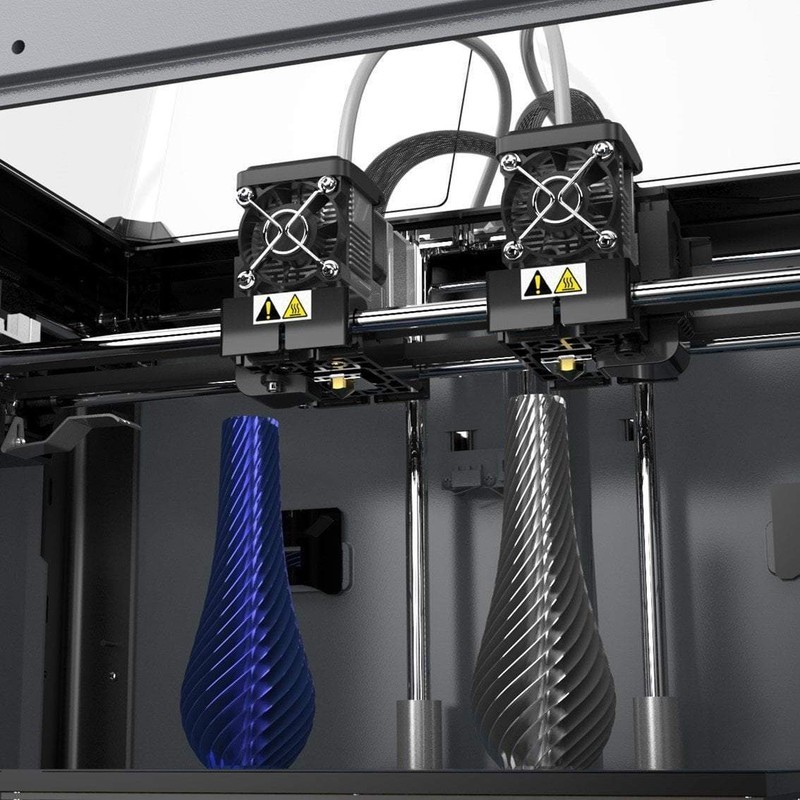
As nothing is perfect, IDEX also has its drawbacks. Firstly, the second print head adds considerable weight, thus introducing the risk of Z-wobbling. Another thing with using IDEX printers is the reduced build volume when printing in single or dual extrusion modes; while duplication mode uses the entire effective build plate area. The example of this is the CraftBot Flow IDEX XL dual extrusion 3D printer. It features the total build area of 425 x 250 x 500 mm, which is reduced to 386 x 250 x 500 mm in single print head mode, and to 351 x 250 x 500 mm in dual print head mode; while duplication mode uses the whole 425 x 250 x 500 mm build area.

The QIDI Tech X-Pro is one of the most affordable dual extrusion FDM 3D printers in the market. The device has an enclosed build chamber and the print volume of 230 x 150 x 150 mm. The X-Pro is equipped with a direct drive dual extrusion module with 4-side air-blow turbofans and two 0.4 mm nozzles with the maximum temperature of 250 °C. The removable magnetic print bed heats up to 110 °C. The 4.3" touchscreen allows for an easy settings adjustment. The maximum layer height of 50 microns and fully enclosed build chamber with a heated print bed ensure consistent printing with all popular consumer plastics, including PLA, PETG, ABS, and TPU. The QIDI Tech X-Pro comes with the QIDI print software.

Credit: reddit.com
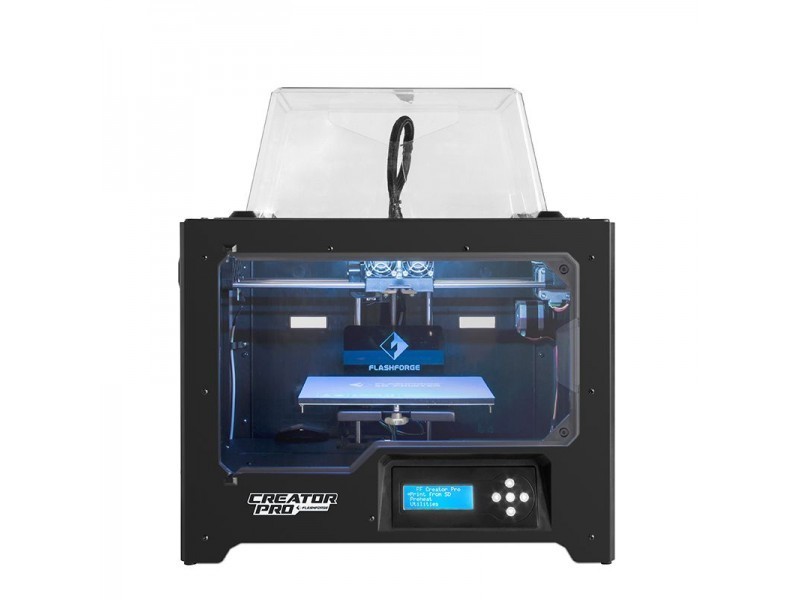
The Flashforge Creator Pro FDM 3D printer is an upgraded version of the Flashforge Creator model. The device features a rigid metal frame and a fully enclosed build chamber of 227 x 148 x 150 mm, and can print up to 60% faster than the original Creator. Probably, the most distinctive feature of the Creator Pro is its dual extrusion system with two dependent print heads, which allow dual-color and dual-material printing, including printing water-soluble support structures. The maximum hotend temperature of 240 °C and the heated removable print bed allow working comfortably with most consumer plastic filaments, such as ABS, PLA, PVA, flexible materials and composites. The Creator Pro is compatible with the proprietary FlashPrint software.

Credit: @kreativeoutlet77 / Instagram

The Flashforge Dreamer is an affordable reliable FDM 3D printer featuring a dual extrusion system. Two dependent print heads allow the user to create dual-material models and build water-soluble PVA support structures. The printer is equipped with two blower cooling fans to avoid warping while printing with PLA-like filaments. The enclosed chamber and the heated print bed ensure compatibility with all the most popular consumer plastics. 100-micron minimum layer height provides decent print quality, but the software allows the user to set up half the layer height for even more detailed prints with smoother surface finish. The build volume of 230 x 150 x 140 mm is enough for most home-use applications. The LED bar inside the printer is convenient when printing in dark environments.

Credit: @tjwill95 / Instagram

The BIBO 2 Touch is a dual extrusion FDM 3D printer with a build volume of 214 x 186 x 160 mm. The device is equipped with a direct drive dual extruder with two hotends, sitting side-by-side on a single print head. Alongside the ability to build dual-color and dual-material models, the BIBO 2 Touch can print in copy printing mode, which allows making two copies of the same part in one go. To reduce the risk of oozing, the inactive hotend is cooled down to 175° C, although such a solution decreases print speed. The fully enclosed build chamber and detachable glass heated print bed make for printing with a lot of filament types, including ABS, PLA, PVA, HIPS, TPU, PC, PETG, nylon, wood, and others. The BIBO 2 Touch is compatible with most popular slicing software, like Cura, Repetier-Host, or Simplify3D. An optional laser-engraving module can be bought separately to expand the functionality of the device.

Credit: @melbamorph / Instagram
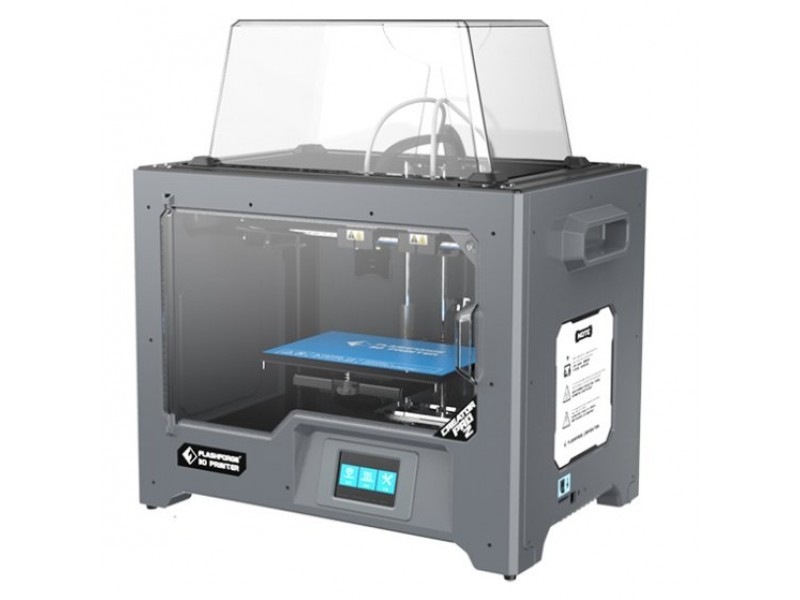
The Flashforge Creator Pro 2 is a Cartesian-style FDM 3D printer featuring an independent dual extruder system, which is rarely found in sub $1,000 models. The IDEX system allows printing not only in multi-material and soluble support modes, but also in mirror and duplication modes, providing a double speed boost. The nozzles can heat up to 240 °C and feature an improved design to prevent clogging. The heated print bed and a fully enclosed build chamber prevent temperature fluctuations and ensure consistent printing results with all consumer filaments, like PLA, ABS, HIPS, TPU and others. The Creator Pro 2 is operated via a 3.5" touchscreen with a clear and simple UI.

Credit: reddit.com

The QIDI Tech i-Fast is an industrial-grade FDM 3D printer featuring a direct drive dual extruder, equipped with wear-resistant ruby nozzles with a maximum temperature of 300 °C, and two nozzle cooling fans. The printer’s build volume is 360 x 250 x 320 mm when printing in a single extruder mode, which is reduced to 330 x 250 x 320 mm for a dual extruder mode. The device is capable of printing two identical models at a time. The i-Fast boasts an enclosed chamber heated up to 60 °C, which is unusual for a (relatively) affordable printer. This feature is extremely useful when printing with temperature-sensitive filaments, like nylon or ABS. The printer is operated via a 5" LCD touchscreen, and supports Wi-Fi and Ethernet connection. It comes with the proprietary QIDI Tech slicer, but is also compatible with Simplify3D and Cura.

Credit: @torquay_audio / Instagram

The Creatbot DX and DX Plus are large-scale industrial-grade FDM 3D printers. The two models differ in the build volume, which is 300 x 250 x 300 mm for the DX model, while the taller DX Plus offers the print volume of 300 x 250 x 520 mm. The Creatbot DX / DX Plus is a unique device, as it features a triple extrusion module that can be equipped with up to three adjustable-height nozzles. The standard nozzle diameter is 0.4 mm, but they can be replaced with 0.3, 0.5, 0.6, 0.8, and 1.0 nozzles, depending on your printing tasks. The maximum hotend temperature of 260 °C allows for printing with a variety of filaments, including PLA, ABS, carbon fiber, PTEG, and others. Both models offer a number of useful functions, such as print resume, filament runout detection, and automatic shutdown, which turns the machine off when printing is over.

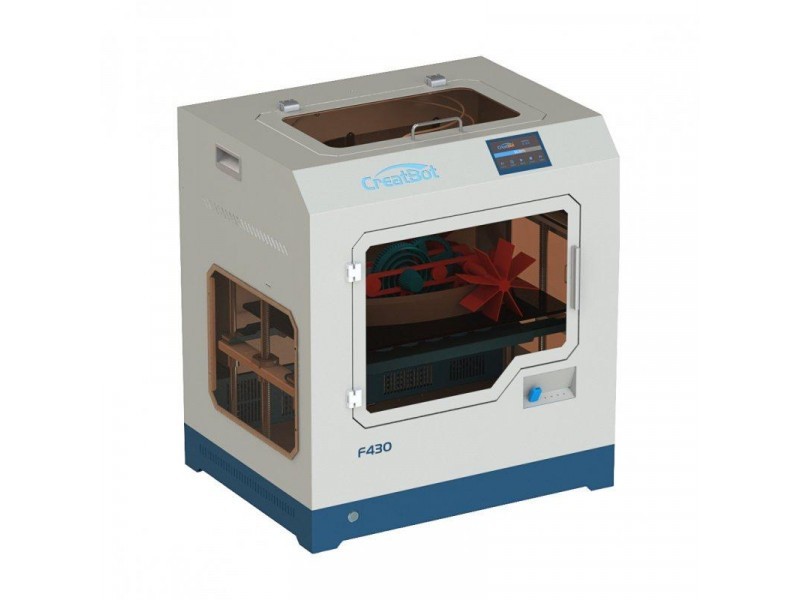
The Creatbot F430 is an industrial-grade FDM 3D printer featuring a dual extrusion system with two different hotends: the left one heats up to 260 °C and is used for printing PLA, ABS, PC, nylon, carbon fiber and flexible filaments, while the right hotend, with the maximum temperature of 420 °C, is made of martensite steel and can print with high performance materials, such as PEEK, ULTEM, etc. The device features a large build volume of 400 x 300 x 300 mm and a ceramic-glass removable print bed. The build chamber can heat up to 70 °C, which allows for reliable high-quality printing with such materials as ABS or PC. The BLTouch auto leveling function allows for proper first layer adhesion and prevents warping.

Credit: @innovative_engines_engineering / Instagram
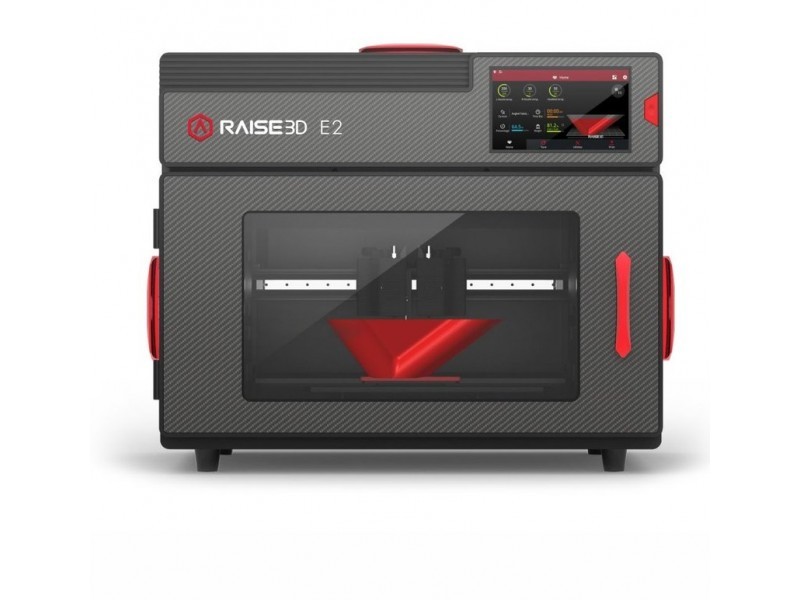
The industrial Raise3D E2 FDM 3D printer is equipped with the Independent Dual Extrusion system which allows doubling the machine’s production volume. The E2 is equipped with two V3P hotends with the maximum nozzle temperature of 300 °C. The standard nozzle diameter is 0.4 mm, which can be replaced with 0.2–1.0 mm optional nozzles. The detachable steel build plate heats up to 110 °C, and can be easily bent for hassle-free print removal. The auto leveling adjusts the nozzle height to keep it at the right distance from the build plate, thus ensuring high-quality prints with proper first layer adhesion. 20-micron minimum layer height provides highly-detailed accurate parts, so that the E2, unlike many FDM machines, can even print dental appliances.

Credit: @3deltaworkshop / Instagram

The Flashforge Creator 3 is a professional dual extrusion FDM 3D printer featuring all the benefits of the IDEX system, namely duplication and mirror modes. The nozzle temperature of 300 °C ensures compatibility with high-performance materials, such as PA, CF, PC, ASA, GF, and others. The heated steel print bed is flexible and can be removed from the printer to conveniently detach the printed part. The build volume of 300 x 250 x 250 mm is large enough for printing sizable parts or batches of smaller models in one go. A 4.5" touchscreen with a user-friendly interface is used for operating the device. Besides, the Creator 3 can be controlled via Wi-Fi, Ethernet, or a cloud-based application.

Credit: @alma.filament / Instagram
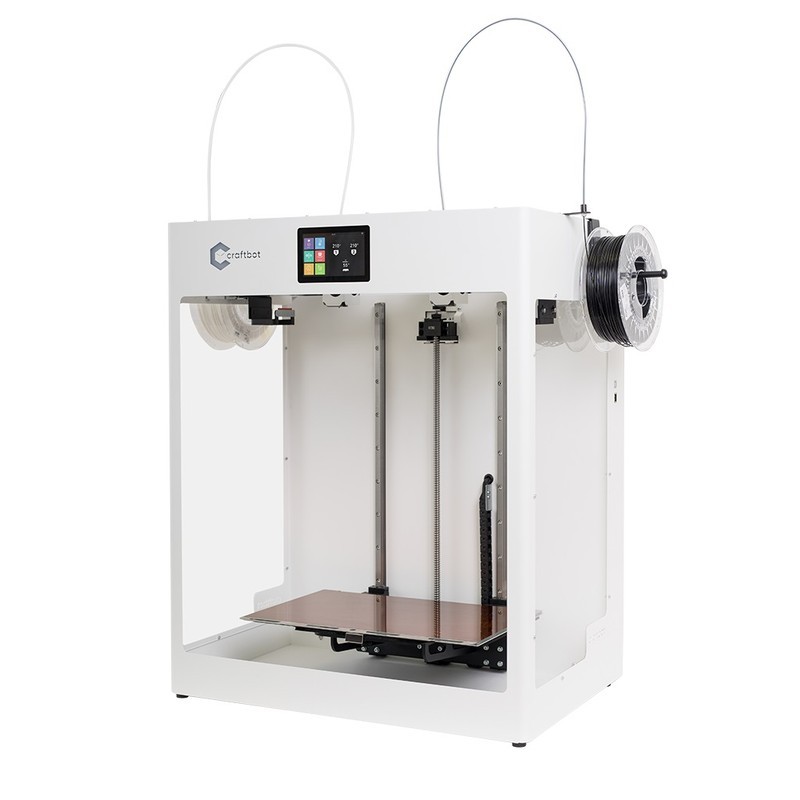
The Craftbot Flow IDEX XL features a large build volume of 425 x 250 x 500 mm and an open design with a sturdy reinforced steel construction. The printer is equipped with the IDEX system of independent dual extrusion. The all-metal hotends with a filament dosage monitoring system support the maximum temperature of 300 °C, which allows printing with high-performance materials. The list of compatible filaments is pretty long, and includes PLA, ABS, PET, nylon, carbon-fiber reinforced composites, wood, and brass. The multilayered heated print bed is made of metal, tempered glass, and Kapton sheets, and can be removed when printing is over.

Credit: @craftbot3d / Instagram

The Raise3D Pro 3 Plus is an upgraded version of the Raise3D Pro 3 FDM 3D printer, featuring the enlarged build volume of 300 x 300 x 605 mm. The dual extrusion system with two independent extruders is equipped with interchangeable nozzles with 0.2–1.0 mm diameters. The maximum operating temperature of 300 °C allows printing with a wide range of materials, including PLA, ABS, HIPS, TPU, PC, nylon, TPE, FLEX, PETG, metallic PLA, wood PLA, carbon fiber, and others. The cooling fan is helpful while working with PLA-type filaments. Featuring the auto bed leveling function and a removable flexible steel build plate, the Pro 3 Plus provides high-quality prints with a perfect first layer adhesion. A bundle of convenient functions, like EVE smart virtual assistant, adds to consistent reliable printing.

Credit: @3d_prima / Instagram

The Modix Big 60 V3 is a large-format industrial FDM 3D printer with the same modular design as all the other Modix machines. The device comes as a DIY kit and allows for a great number of various upgrades, including the enclosure for the build chamber. The huge build volume of 600 x 600 x 660 mm gives the opportunity to print almost any model as one piece. By default, the Big 60 V3 is equipped with an E3D Aero direct extruder and a V6 Volcano hotend. The new Duet 2 controller unit supports dual extrusion, as well as a lot of other useful features, so the printer can be upgraded with an improved dual print head for multi-material or multi-color printing. BLTouch auto bed leveling ensures the proper distance between the nozzle and the build plate. The maximum hotend temperature of 285 °C and the heated build plate make for the printer’s compatibility with a great number of filaments, like PLA, PETG, PVA, ABS, ASA, PC, nylon, TPU, carbon composites and others.
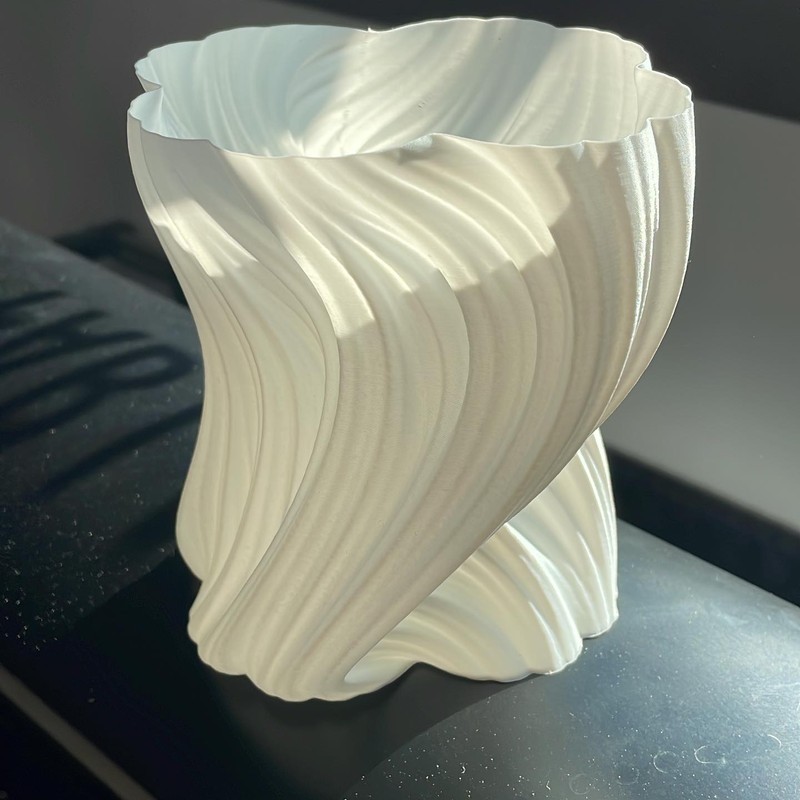
Credit: @fablablepointu / Instagram

The large-scale professional FDM 3D printer Creatbot D600 Pro features the common for Creatbot devices dual-extrusion system, with the left 260°C hotend for printing with standard plastics, like PLA, ABS or flexible materials, and the right hotend that can reach the temperature of 420°C — for high-performance thermoplastics such as PC and high-temperature nylons. The spacious build volume of 600 x 600 x 600 mm makes the D600 Pro perfectly suitable for a variety of industrial applications. The heated air chamber makes for more predictable printing results with such filaments as nylon or ABS. BLTouch auto leveling function ensures perfect first layer adhesion and reduces the risk of print failures. The D600 Pro comes with the free CreatWare software based on the popular Cura slicer.

Credit: @ilmakerspaces / instagram
A dual extruder 3D printer, as the name suggests, is equipped with two extruders, which allows the user to combine two (or sometimes more) filaments in one project. There are different types of a dual extrusion system, with the IDEX being the most powerful. Besides multi-color and multi-material printing, as well as printing soluble support structures, it features duplication and mirror modes, which can double the production volume.

Credit: bigrep.com
The Creality Ender-3 is a very popular model of an affordable consumer FDM 3D printer. It is equipped with a single extruder, but there are some options allowing the user to upgrade it to the dual extrusion system. The most obvious and safe way to do it is to buy a filament splicer, or changer, that can work with most FDM 3D printers (more of that below).
Another option is to upgrade your printer with one of the DIY open-source solutions, but they usually require serious modifications that are often irreversible. So, be sure that you really need it. The most popular modifications are DIY Chimera Project, Cyclops Hot End, and some others.

Yes, they can. Dual extruder printers can use one nozzle for printing the part with the main material (PLA, for example) and the other for PVA water-soluble supports. For ABS parts, HIPS (which dissolves in limonene) is often used for building support structures.

Credit: simplify3d.com
When two nozzles are used instead of one, the overall printing time shortens significantly. Moreover, with the IDEX printers, you can double the productivity of your device using duplication and mirror modes.
Normally, FDM 3D printers are equipped with a single or dual extrusion system. There are a few printer models in the market featuring triple extrusion, but they are not so popular, as the dual extrusion system is complicated enough and requires more maintenance, not to mention the triple one. There are also various third-party mods allowing for three or even four-nozzle setup.
The situation is pretty much the same as with single extrusion models. Most entry-level consumer devices feature an open design, which sometimes can be complemented with an optional enclosure. More expensive professional-grade printers are usually fully-enclosed. The enclosure is absolutely necessary if you plan on printing with high-performance materials.
With IDEX printers you can print two copies of the same model either in duplication or in mirror mode.

With the development of 3D printing, a lot of technologies that were only used in professional printers have now become affordable for consumers. Today you can buy an entry-level dual extrusion 3D printer for less than $500.
In dual extrusion printers, you don't have to manually change filaments to print with different materials, as they are equipped with two extruders, and the switch between them happens automatically. Dependent dual-extrusion systems only allow printing with two filaments in turn, while IDEX printers can use both nozzles simultaneously, increasing the print speed.
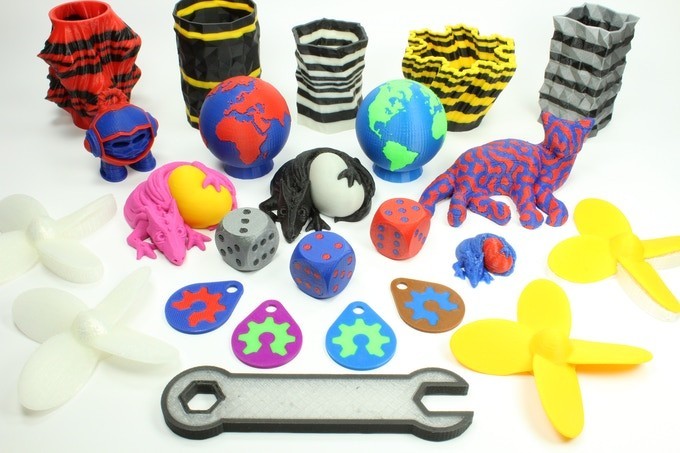
Credit: kickstarter.com
If you already have a single extruder FDM 3D printer, you do not necessarily have to buy a dual extrusion device to give a try to multi-material printing. You can upgrade your printer with a filament splicer, like the Mosaic Palette 3 Pro, mentioned above.
Another affordable option is the 3D Chameleon automatic color changer, allowing for the use of up to four filaments in one model.
One more way to make your printer work with different filaments (up to 12!) is the SMuFF V6 — an open-source DIY smart multi-filament feeder. It may not be the choice for beginners, as it requires certain skills in configuring your printer’s firmware, but if you feel confident with that, it is definitely an option.
Update your browser to view this website correctly. Update my browser now
Write a comment